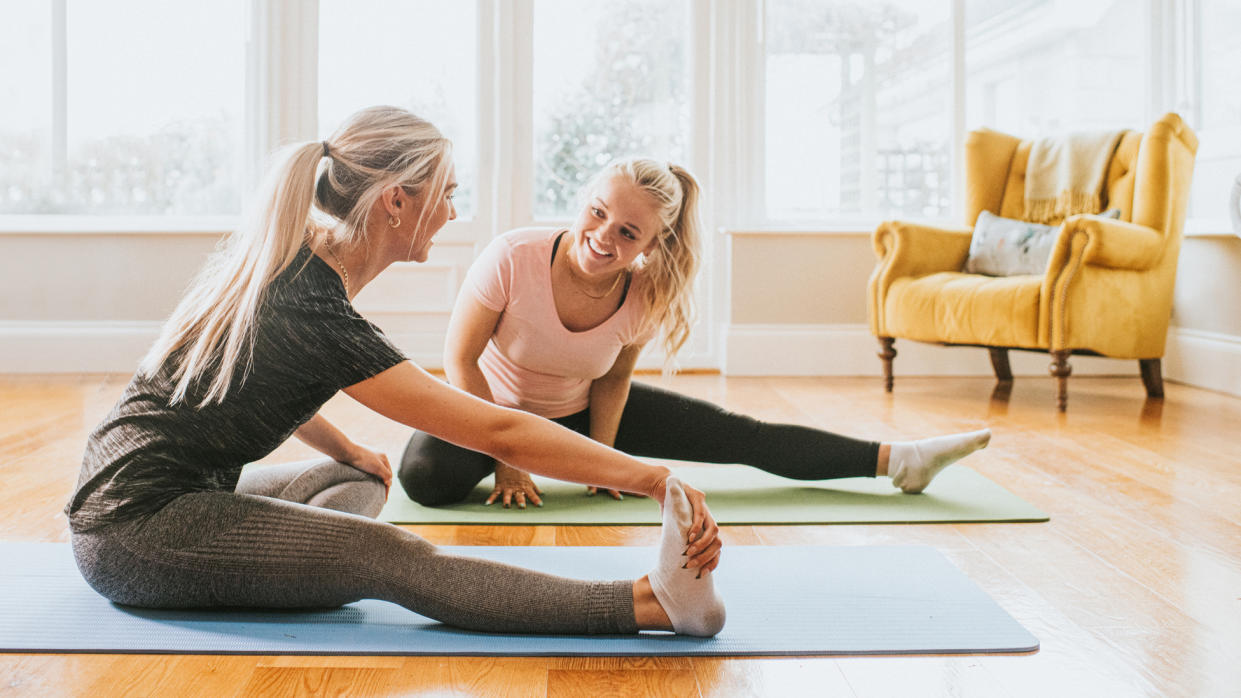An expert says you should strengthen your hips rather than just stretching them to "sort out tight hips for good"

If you spend a lot of your time sitting down, you might suffer from stiff and achey hips. Stretching them out feels like the logical solution, but there's a better way to soothe soreness in the long term.
"Stretching gives you a quick fix, helping you feel good for a bit, but unfortunately that feeling maxes out at about seven minutes,” says sports therapist, strength and conditioning coach and Lincs Injury Clinic founder Emma Burgon-Kisby.
"Working on your hip strength is the way forward if you're looking to sort out tight hips for good," she adds.
To help Fit&Well readers in their mission for healthier hips, Burgon-Kisby has shared some of her favorite hip-strengthening moves below. The main focus in the routine is the hip flexors—the muscles on the front of the hip responsible for bringing the knees towards the chest—but you’ll also strengthen and stretch other areas like the trunk and legs to build long-lasting stability.
Hip strengthening exercises
1. Deadbug
How to do it
Lie on your back, making sure you can feel your lower back on the ground. Tuck your tailbone up towards the ceiling and clench your glutes (butt muscles). Lift your legs so your knees are above your hips and your knees are at roughly 90°. Extend your arms towards the ceiling.
Tense your abs and, as you breathe out, extend your right leg so it’s just above, but not resting on, the floor. At the same time, lower your left arm so it is also just above the floor above your head.
Bring both limbs back to the starting position, then repeat the movement using the opposite limbs.
Benefits of deadbugs
Burgon-Kisby says this move is excellent for strengthening and lengthening the hip flexors, as well as the muscles in your deep core which play a major role in stabilizing the hips and lower back.
2. Towel slides
Lie on your back on a smooth floor with your legs straight out in front of you. Point your toes towards the ceiling and place a towel underneath your heels.
Press your heels into the ground to raise your glutes off the floor, then use your feet to slide the towel towards you.
Push the towel back to the starting position with your feet, then repeat.
Benefits of towel slides
Towel slides are a brilliant way to target the muscles responsible for straightening your leg at the knee and moving your leg behind you. This exercise will work these muscles through their full range of motion, helping you develop stability and control in these areas.
"Towel slides can also have many progressions and regressions, making it a great exercise for everyone's ability—I even use it with the paralympic athlete I work with," adds Burgon-Kisby.
3. Knee tucks
Sit on the edge of a bench or sturdy surface that’s roughly knee height with your legs straight and your heels resting on the ground (as in the second exercise demonstrated in the video above). Place a short looped resistance band around the middle of your feet.
Place both hands over the edge of the surface, facing forwards, so they’re about shoulder-width apart, then straighten your arms so you’re supporting your weight between your hands and your heels.
Draw your right knee towards your chest until your thigh is perpendicular with your torso, pause for a second, then lower it back to the starting position. Alternate the knee you raise with each repetition.
Benefits of knee tucks
Knee tucks allow us to work the hip joint and surrounding muscles through a large range of motion. Adding the resistance band will increase the load your muscles have to work against, making them stronger and priming them for functional daily movements.
"It’s also a movement that can improve posture and the walking gait [the pattern of how you walk]," says Burgon-Kisby.
4. Knee lifts
Stand on a box, step, or bench with your left foot along the right side and your right foot hovering over the edge. Hook the end of your right shoe through the handle of a light kettlebell.
Engage your core then, keeping your body straight and facing forward, raise your right knee as high as you can, then slowly lower it back to the starting position. Repeat for the prescribed repetitions, then do the same on your left leg.
Benefits of knee lifts
This movement pattern may feel familiar—you lift your knee like this when running or climbing stairs. Adding resistance with a kettlebell (or a short resistance band looped around the middle of both feet) places more demand on your hip flexor muscles to strengthen them. And that’s not all.
"Knee lifts are another one that can improve posture and the walking gait," Burgon-Kisby says. "This variation not only strengthens the muscles being used but also improves their endurance and resilience under load."
So, whether you’re exercising, playing sports, or simply going about your daily routine, the muscles will perform better and have a reduced risk of injury.
Hip strength exercises vs. hip stretches
The muscles surrounding our hips can weaken if we don't use them enough, which happens if we spend most of our time sitting down. So Burgon-Kisby's suggestion to focus on strengthening, rather than stretching them, makes sense if you're trying to undo this damage and rebuild these muscles.
"Making sure you're moving your hip flexors through their full range is key to mobility for the long haul, and it can even help ease off back pain, hip pain, and knee pain and keep you steady during squats and lunges," she adds.
Strengthening other areas of your lower body can also help fight the effects of sitting down all day. If that's your aim, have a look through our list of the best glute exercises, or try doing this squat workout.

